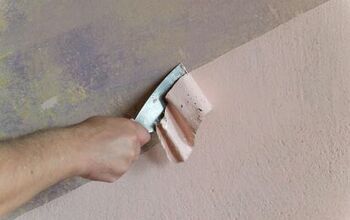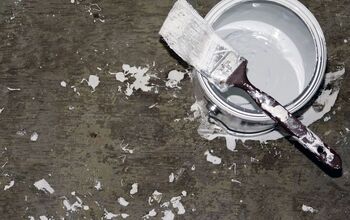How To Paint Concrete Floors

Most homes have at least one concrete floor that looks rather unsightly. Whether it’s in the garage or the basement, or even throughout the home, concrete floors can make an otherwise fabulous home look a bit drab.
It makes sense that you might want to find an affordable, effective and visually appealing way to cover concrete. Painting is a great way to give floors a facelift, but it is important you take some specific steps when you decide to paint concrete floors.
When painting concrete floors, make sure to take the time to clean any stains, paint and surface imperfections. Once the floors are clean, use an etching solution on the concrete, as this will help paint adhere to the surface. Fill cracks to ensure the surface looks smooth, and then apply a primer layer. Apply a paint that is specifically suited for your type of concrete floor.
Painting concrete floors is a fairly straightforward DIY project, and is something that anyone with a bit of painting knowledge can pull off. The key is making sure you choose the right paint and materials and don’t skip any of the necessary steps.
If you are getting ready to paint your concrete floors, make sure you continue reading to learn all the essential steps, tips and tricks involved when painting a concrete floor.
Things To Know When Painting Concrete
Every surface reacts a bit differently to paint, and that’s why paint stores have hundreds of paint types instead of just one. Concrete surfaces are no exception. As you embark on a painting project that involves concrete surfaces ,there are a few things you should know so you don’t buy the wrong paint or skip an essential step in the painting process.
Concrete Surfaces Absorb Moisture
Unlike metal, plastics and many other surfaces, concrete absorbs water. Most paints (especially latex and other water-based paints) are mostly water, which means that the concrete is likely to react to the water absorption.
This is why when choosing a paint (especially if you choose a water-based paint), you need to choose one that is specifically made for concrete. Luckily, there are all sorts of paints that are created to apply directly onto concrete surfaces. Make sure you buy one of these rather than picking a paint just because you like the color or sheen.
Don’t Skip Primer And Prep Steps
Concrete is porous and not the strongest surface to bond to. If you think you can just grab the paint (even if it is good paint), and apply it directly to a raw concrete surface, you are likely to end up with an unprofessional and sloppy result.
Make sure you spend time cleaning, etching and preparing your concrete surfaces. Once this work is done, make sure you apply at least one layer of primer. Some primers suggest you use multiple coats, so follow the instructions for your particular primer. Otherwise, the concrete surface might struggle to hold onto the paint, which can cause premature peeling and cracking.
Choose The Correct Paint For Each Type Of Concrete Floor
It is also important to remember that not every concrete floor is the same. Some concrete floors, like garage floors, require a paint that is very durable and able to take a beating. Other floors, like a guest room floor that has a throw rug, might not need such a strong and durable paint. It is also important to choose the right paint based on whether you are painting a sealed concrete floor or one that is not sealed.
Make sure you are considering the room where the concrete floor is and buy the right paint for it. If you are uncertain, simply ask your local paint professional to guide you towards the right concrete floor paint for your specific needs.
Step By Step Guide To Painting Concrete Floors
Step One: Research And Purchase The Right Paint
Before you even prepare your areas, make sure you do your research to purchase the right paint, primer and etching solution for the job. If you are at all uncertain, simply consult with a paint professional and let them know the type of concrete floor you are painting and the type of results you seek.
Step Two: Clean Your Concrete Surface
Cleaning and preparing your concrete surface is crucial. It is slightly more involved than prepping walls, as concrete tends to have more imperfections than walls. If you have bumpy areas, cracks or stains on the concrete, these should all be addressed.
Remember that painting concrete will change the look of the surface, but the surface imperfections will remain. In fact, painting concrete floors often has a tendency to bring to light these imperfections on the surfaces. Consider renting a concrete grinder, or at least using a wire brush to buff out any of these wonky areas before moving to the next step.
Step Three: Apply Etching Solution To Concrete
Many paints and primers suggest you apply an etching solution beforehand. Even if the instructions don’t explicitly say this, it is still usually a good idea. Applying an etching solution to concrete is similar to sanding down a typical surface in that it helps the paint adhere.
When you apply an etching solution, you give the primer something to grip onto, which usually yields better and longer lasting results. Remember that these solutions can have some potent fumes, so always make sure you have open windows, ample fans and air circulation in addition to your typical safety equipment.
Step Four: Fill In Any Cracks In Concrete And Smooth The Surfaces
Once you apply the etching solution, you can use concrete sealer to fill any cracks and imperfections, and smooth them out with a putty knife.
Step Five: Prepare The Room For Painting
Just like with any other surfaces, make sure you clean and dry your concrete floors. Remove everything from the room and tape off the edges for more precise lines.
- Pro Tip: Try to choose a time to paint when the relative humidity is fairly low. You don’t want to paint concrete, or any surfaces when the relative humidity is above 80%.
Step Six: Add Primer Layer
Apply a primer layer. Typically, it is best to use a brush to paint along the perimeter. Then use a nap roller to apply primer to most of the floor. This is not only easier, but also leads to smooth and more even coats. Apply two coats if required, allowing ample drying time between coats.
Step Seven: Roll On Your Paint Layers
Once your primer is completely dry, you are ready to apply the paint layer. Remember that you can add tint to your paint to help perfectly match the room. But most of all, make sure you have selected the right paint for the surface in question. Apply paint just like the primer, using a brush for the edges and a roller for the majority of the floor.
Step Eight: Allow Ample Drying Time And Inspect Results
Make sure you inspect your results and ensure the finish is smooth and even. Once you are satisfied with the results, make sure you wait ample time (ideally a full week but at least 3 days) before moving any furniture in the room. Your paint might not be fully cured even when it is dry to the touch. Furthermore, since concrete absorbs moisture, it can take even longer for the paint to cure depending on environmental factors.
Wrapping Up How To Paint Concrete Floors
Painting concrete floors is a great way to liven up an otherwise boring floor situation. While it is entirely possible to paint your concrete floors yourself, if you want great results, then you need to follow specific steps. First, make sure you prep the area and scrape off and fill any imperfections.
Use an etching solution so the paint adheres better to the surfaces. Next, apply at least one (often two) layers of primer. Then you will apply the paint. Make sure you select the right paint for the specific concrete surface you are painting. If you are uncertain, enlist the help of a paint professional.
Related Guides:

Tom Gaffey is an expert writer who currently resides in Washington D.C. Tom has a passion for real estate and home improvement writing, as well as travel and lifestyle writing. He lived the last twelve years in Hawaii where he worked closely with luxury resorts and event planners, mastering his knowledge of aesthetics and luxury products. This is where he found his passion for home improvement and a keen interest in DIY projects. Currently, Tom resides in Washington D.C, and also working on his debut fiction novel.
More by Tom Gaffey



























